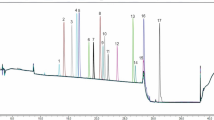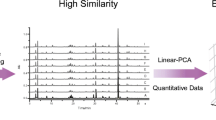Abstract
Scutellaria lateriflora, commonly known as skullcap, is used as an ingredient in numerous herbal products. However, it has been occasionally adulterated/contaminated with Teucrium canadense and/or Teucrium chamaedrys, commonly known as germander, due to the morphological similarities between the two genera. The latter contains hepatotoxic diterpenes. Despite the potential hepatotoxicity introduced by germander contamination, analytical methodologies for the authentication and quality assessment of S. lateriflora-based dietary supplements have not been reported. In this study, a flow-injection/mass spectrometry fingerprinting method in combination with principal component analysis was used to survey S. lateriflora-based dietary supplements sold in the USA.






Similar content being viewed by others
References
Barnes J, Anderson L, Phillipson JD (2002) Herbal medicines: a guide for healthcare professionals, 2nd edn. Pharmaceutical, London
Rafinesque CS (1830) Medical flora: or, manual of medical botany of the United States of North America. Atkinson & Alexander, Philadelphia, p 227
King J (1866) The American dispensatory. Moore Wilstach & Baldwin, Cincinnati, p 1509
Milla S, Bone K (2000) Principles and practice of phytotherapy. Church Livingstone, Edinburgh, p 643
Sarris J (2007) Phytother Res 21:703–716
Wolfson P, Hoffmann DL (2003) Altern Ther 9:74–78
Awad R, Arnason JT, Trudeau V, Bergeron C, Budzinski JW, Foster BC, Merali Z (2003) Phytomedicine 10:640–649
Gafner S, Bergeron C, Batcha LL, Reich J, Arnason JT, Burdette JE, Pezzuto JM, Angerhofer CK (2003) J Nat Prod 66:535–537
Xu Z, Wang F, Tsang SY, Ho KH, Zheng H, Yuen CT, Chow CY, Xue H (2006) Planta Med 72:187–189
Bedir E, Manyam R, Khan IA (2003) Phytochemistry 63:977–983
Sundaresan PR, Slavoff SA, Grundel E, White KD, Mazzola E, Koblenz D, Rader JI (2006) Phytochem Anal 17:243–250
Rader JI, Delmonte P, Trucksess MW (2007) Anal Bioanal Chem 389:27–35
Kouzi SA, McMurtry RJ, Nelson SD (1994) Chem Res Toxicol 7:850–856
Haouzi D, Lekehal M, Moreau A, Moulis C, Feldmann G, Robin MA, Letteron P, Fau D, Pessayre D (2000) Hepatology 32:303–311
Bruno M, Cracuata M, Bondi ML, Pizza F, De la Torre M, Rodríguez B, Servettaz O (1998) Phytochemistry 48:687–691
Bruno M, Piozzi F, Rosselli S (2002) Nat Prod Rep 19:357–378
Rosselli S, Maggio A, Piozzi F, Simmonds MS, Bruno M (2004) J Agric Food Chem 52:7867–7871
Harborne JB, Baxter H (1999) Scutellaria spp. in “Species index”. The handbook of natural flavonoids, vol 1. Wiley, New York, pp. 878–879 (vol 2, p. 868)
Gafner S, Bergeron C, Batcha LL, Angerhofer CK, Sudberg S, Sudberg EM, Guinaudeau H, Gauthier R (2003) J AOAC Int 86:453–460
Bergeron C, Gafner S, Clausen E, Carrier DJ (2005) J Agric Food Chem 53:3076–3080
Sticher O, Lahloub MF (1982) Planta Med 45:157
Kadifkova Panovska T, Kulevanova S, Stefova M (2005) Acta Pharm 55:207–214
Serrilli AM, Ramunno A, Rullo R, Ballero M, Serafini M, Bianco A (2007) Nat Prod Res 21:814–818
Lin LZ, Harnly JM, Upton R (2009) Phytochem Anal 20:298–306
Harnly JM, Pastor-Corrales MS, Luthria DL (2009) J Agric Food Chem 57:8705–8710
Fraga BM, Hernandez MG, Fernandez C, Santana JMHA (2009) Phytochemistry 70:1038–1048
Luthria DL, Lin L-Z, Robbins RJ, Finley JW (2008) J Agric Food Chem 56:9819–9827
Avula B, Ali Z, Khan IA (2007) Chromatographia 66:757–762
Reynolds T (2007) Phytochem 68:2887–2895
Chen P, Lin LZ, Harnly JM (2010) J AOAC Int 4:1148–1154
Acknowledgements
This research is supported by the Agricultural Research Service of the US Department of Agriculture and an Interagency Agreement with the Office of Dietary Supplements of the National Institutes of Health.
Author information
Authors and Affiliations
Corresponding author
Rights and permissions
About this article
Cite this article
Sun, J., Chen, P. A flow-injection mass spectrometry fingerprinting method for authentication and quality assessment of Scutellaria lateriflora-based dietary supplements. Anal Bioanal Chem 401, 1577–1584 (2011). https://doi.org/10.1007/s00216-011-5246-2
Received:
Revised:
Accepted:
Published:
Issue Date:
DOI: https://doi.org/10.1007/s00216-011-5246-2




